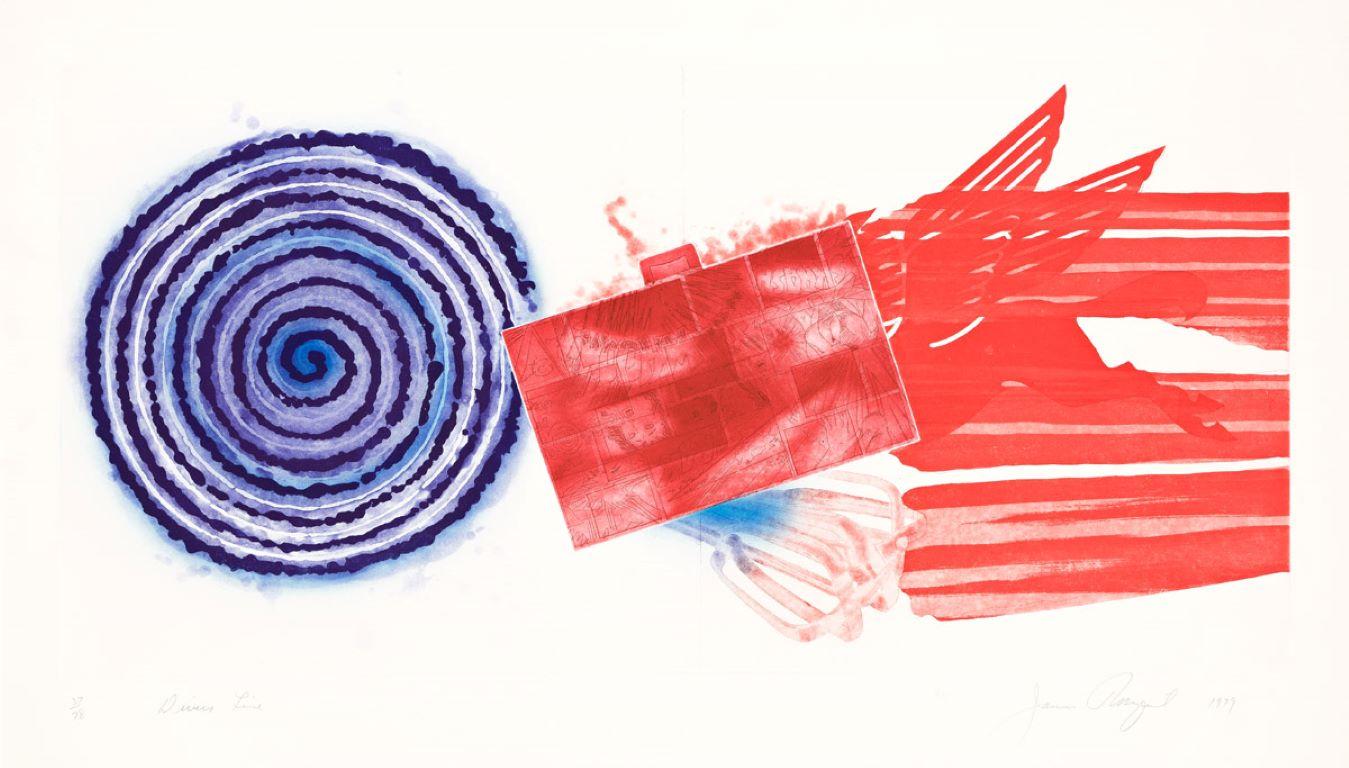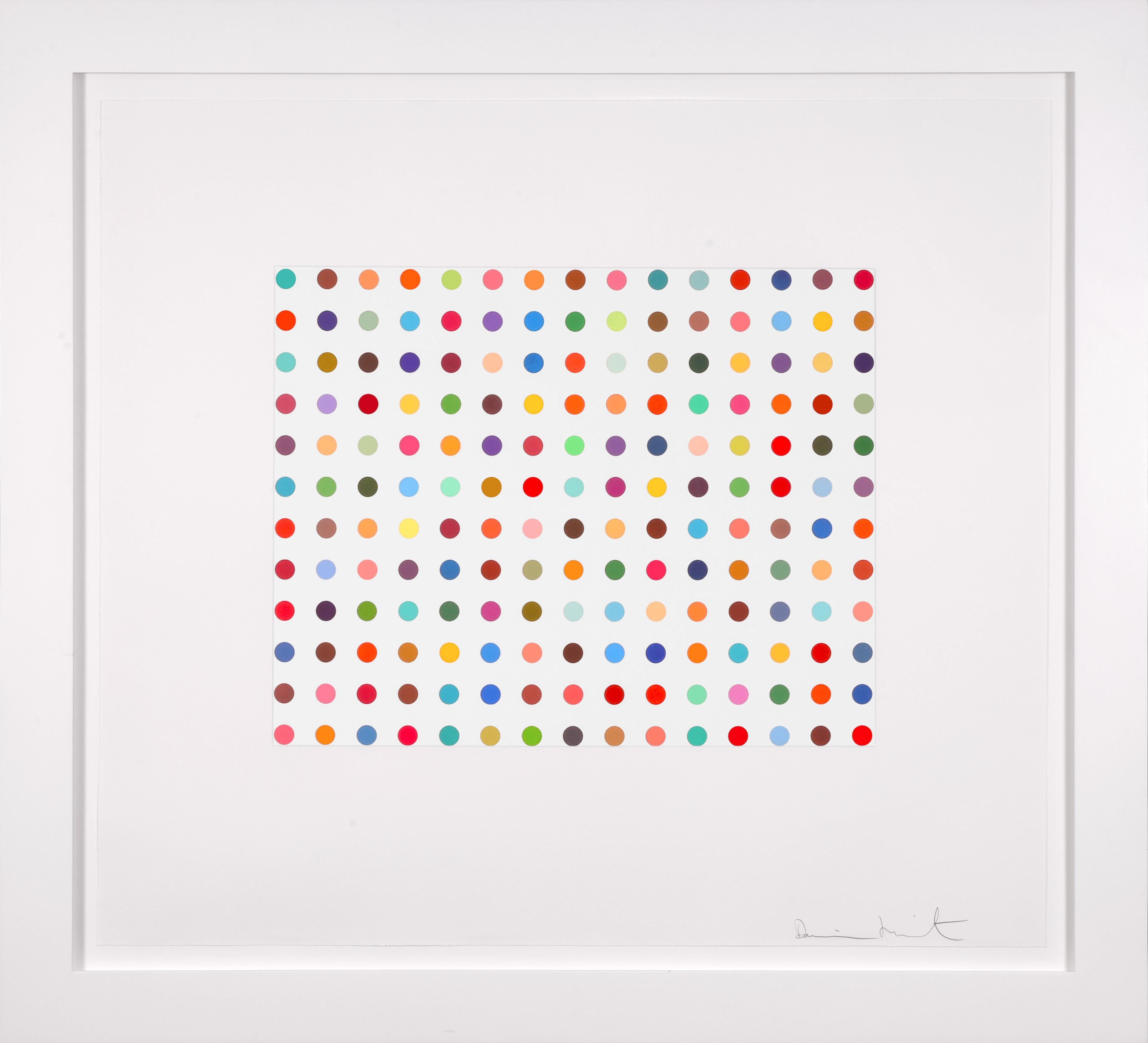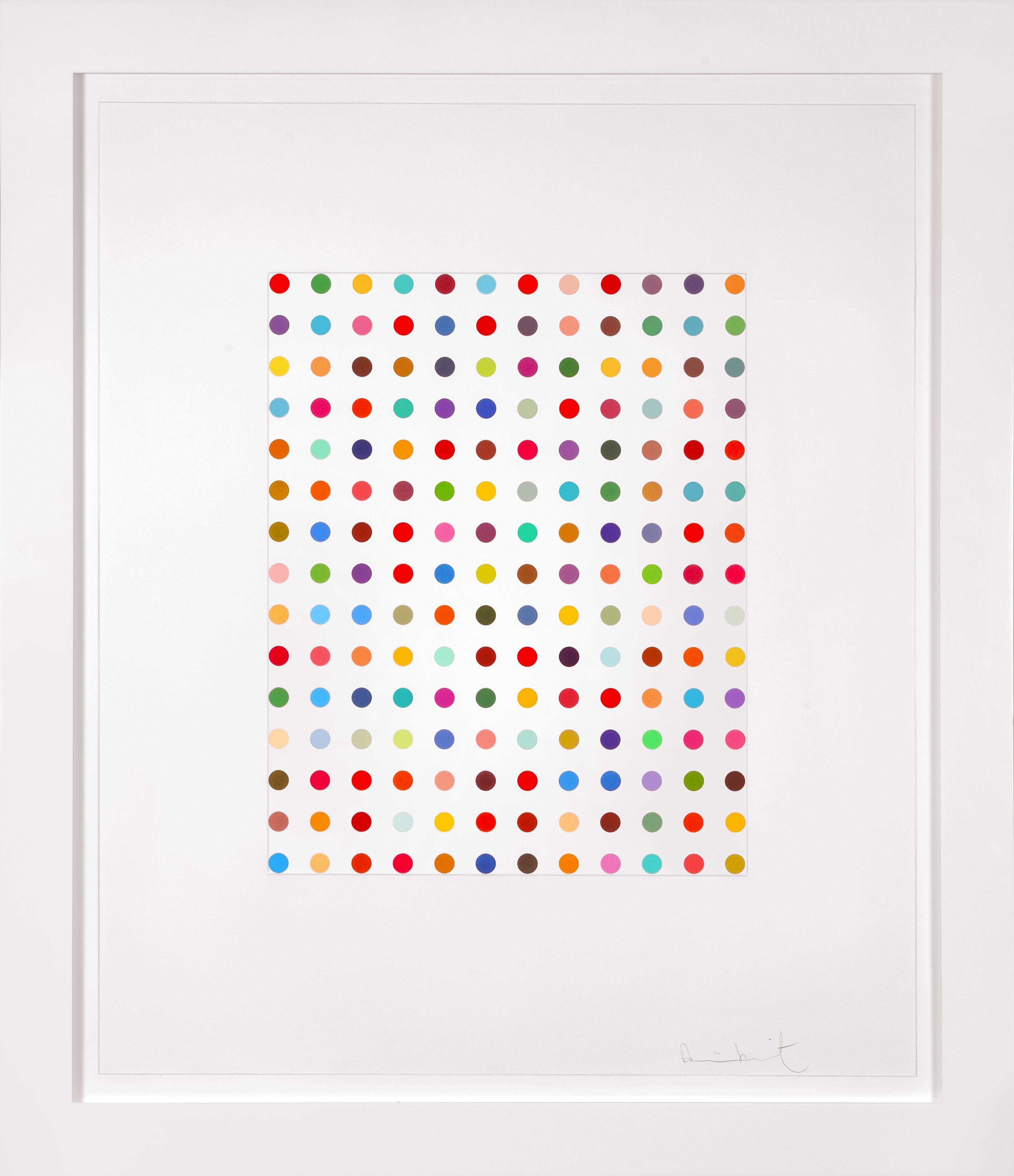Donald SultanOne of Diamond and Thirteen of Diamonds1990
1990
About the Item
- Creator:Donald Sultan (1951, American)
- Creation Year:1990
- Dimensions:Height: 25.5 in (64.77 cm)Width: 35.5 in (90.17 cm)Depth: 1 in (2.54 cm)
- Medium:
- Movement & Style:
- Period:
- Condition:
- Gallery Location:Missouri, MO
- Reference Number:1stDibs: LU74735819472
Donald Sultan
Donald Sultan is a distinguished painter, sculptor, and printmaker who rose to prominence in the late 1970s as part of the “New Image” movement in New York City.
Sultan has a unique artistic method and innovative approach to traditional subject matter. Known as Abstract Representation, Sultan’s paintings, prints and other art are characterized by the use of geometric black forms set against organic areas of bright color, thus bringing an abstract sensibility to his iconographic images of still life. Throughout his career he has revisited and reinvented still life, using images of lemons, poppies, playing cards, fruits, flowers, and other objects. Sultan’s lemons, a recurrent theme in his artworks, have in fact become an iconic image all over the world.
“All of the images of those dark pictures are really about the architecture in the paintings; they seem so massive and strong and permanent, but nothing is permanent,” Sultan has said. “The image in the front is very fragile, but it conveys the loaded meaning of everything that is contained in the painting.”
Sultan is considered to be at the forefront of contemporary art. Although his paintings are often classified as landscapes and still lifes, Sultan states that they are first and foremost abstracts. Besides paintings, drawings, and sculptures, he has created many editions. Sultan’s prints are unique: he uses specific materials like “flocking” to create expressive and powerful prints that are reminiscent of his forceful paintings. Since his first solo exhibition in 1977, Sultan’s artistic career has progressed rapidly; his works are part of the most prominent public and private collections to be found across the globe.
Find original Donald Sultan art on 1stDibs.
(Biography provided by Weng Contemporary — ArtXX AG)
- ShippingRetrieving quote...Ships From: Missouri, MO
- Return PolicyA return for this item may be initiated within 2 days of delivery.
- FodderBy John CostiganLocated in Missouri, MOFodder by John Costigan (1888-1972) Signed Lower Right Titled Lower Left 9.75" x 12.75" Unframed 17.5" x 19.75" Framed John Edwards Costigan was born in Providence, Rhode Island on ...Category
20th Century American Impressionist Landscape Prints
MaterialsEtching
- Brown CottonwoodLocated in Missouri, MOBrown Cottonwood, 2005 By Andrew Millner (American, b. 1967) Lightjet Print Mounted on UV Plex Signed Lower Right Unframed: 87" x 44" Framed: 88" x 45" Andrew Millner is a visual artist based in St. Louis, MO. His work investigates the relationship between art and nature, the natural and the made. Millner received a BFA from University of Michigan, in Painting and Sculpture. He has had more than 56 group exhibitions since 1987 and over 15 solo exhibitions at institutions including Miller Yezerski Gallery, Boston, Massachusetts; Ellen Miller Gallery, Boston, Massachusetts; CCA, Santa Fe, New Mexico; Tria Gallery, New York City, New York; Richard Levy Gallery, Albuquerque, New Mexico; David Floria Gallery, Aspen, Colorado; Contemporary Museum St. Louis, St. Louis, Missouri. "I started drawing on the computer in 2005. Previous to that, most of my work had been about finding lines in nature; the contours of leaves, the ripples on rivers, the edges of overlapping hills. Although I was using traditional art materials, I prepared the canvases with slicker and slicker surfaces so that the lines wouldn’t soak into the background but sit on top, preserving the nuances of my hand. I thought of the drawings as photographic, in the diaristic sense of recording moments of time. I enjoyed the easy correspondence of the endless novelty of line in these natural forms and the endless variety of line created by my hand. I couldn’t draw the same leaf twice so my subject and process were well matched. I had the idea to draw every leaf of a tree, but I struggled with the scale and complexity of the subject. How does one bring a tree indoors? How can one see the whole tree and its individual parts simultaneously? I tried traditional strategies and materials but the results were unsatisfactory. I wondered if it would be possible to make the drawing on a computer. Since everything… music, photos, movies & books were being digitized, what about drawing? I wasn’t interested in something computer-generated, but sought to “dumb down” the computer and use it as a repository for simple line drawings. In the program I use, Adobe Illustrator, lines are called “paths”… an apt name since the line exists at no set scale or color. Only later do I assign the attributes of color and thickness. Taking my laptop outdoors, I drew my first tree “en plein air.” Using a digital tablet and pen, I drew simple contours of the leaves and branches. Having these drawings remain in digital form rather than in physical form, opened up interesting possibilities and enabled me to tackle the complexity of a tree in intriguing ways. My lines were free and separate from the background and from each other. I drew the branches individually and then later, I could cobble them together to reconstitute the whole tree. On the screen, I could zoom in and out and draw at different scales simultaneously. I could zoom out to draw a simple contour of the entire trunk and then zoom in to draw the smallest leaf with equal effort. I drew in layers so that as the drawings accumulated I could turn layers “off” so that they wouldn’t obscure subsequent layers. These two novelties, drawing at different scales simultaneously and making parts of the drawing invisible to allow for work on top or behind previous drawings, allowed for the accumulation of hundreds of simple outlines to create a dizzying visual complexity. Subsequent trees I drew from photographs. I would take hundreds of close-ups of a tree from a single point of view and then stitch all of these close ups together on the computer. Sometimes I photographed the same tree in the summer and then in the fall after it lost its leaves. This allowed me to see and draw all of the branches and limbs unadorned and unobscured. I would draw the tree twice, with and without leaves, merging the two drawings into one document. In this way, the drawings comprise and compress great spans of looking over vast time frames and seemingly contradictory close-up and distant points of view. My digital drawings have been outputted in different ways… mostly as photographs printed directly from the digital file or as archival inkjet prints. The results defy easy categorization. Are they drawings, prints, or camera-less photographs...Category
21st Century and Contemporary American Modern Still-life Prints
MaterialsPlexiglass, Inkjet
- Observador de PajarosBy Rufino TamayoLocated in Missouri, MO"Observador de Pajaros" 1950 By. Rufino Tamayo (Mexican, 1899-1991) Edition 83/210 Lower Right Signed Lower Left Unframed: 15.5" x 22.5" Framed: 21.75" x 28.25" Rufino Tamayo (August 26, 1899- June 24, 1991) A native of Oaxaca in Southern Mexico, Rufino Tamayo's father was a shoemaker, and his mother a seamstress. Some accounts state that he was descended from Zapotec Indians, but he was actually 'mestizo' - of mixed indigenous/European ancestry. (Santa Barbara Museum of Art). He began painting at age 11. Orphaned at the age of 12, Tamayo moved to Mexico City, where he was raised by his maternal aunt who owned a wholesale fruit business. In 1917, he entered the San Carlos Academy of Fine Arts, but left soon after to pursue independent study. Four years later, Tamayo was appointed the head designer of the department of ethnographic drawings at the National Museum of Archaeology in Mexico City. There he was surrounded by pre-Colombian objects, an aesthetic inspiration that would play a pivotal role in his life. In his own work, Tamayo integrated the forms and tones of pre-Columbian ceramics into his early still lives and portraits of Mexican men and women. In the early 1920s he also taught art classes in Mexico City's public schools. Despite his involvement in Mexican history, he did not subscribe to the idea of art as nationalistic propaganda. Modern Mexican art at that time was dominated by 'The Three Great Ones' : Diego Rivera, Jose Clemente Orozco, and David Alfaro Siqueros, but Tamayo began to be noted as someone 'new' and different' for his blending of the aesthetics of post Revolutionary Mexico with the vanguard artists of Europe and the United States. After the Mexican Revolution, he focused on creating his own identity in his work, expressing what he thought was the traditional Mexico, and refusing to follow the political trends of his contemporary artists. This caused some to see him as a 'traitor' to the political cause, and he felt it difficult to freely express himself in his art. As a result, he decided to leave Mexico in 1926 and move to New York, along with his friend, the composer Carlos Chavez. The first exhibition of Tamayo's work in the United States was held at the Weyhe Gallery, New York, in that same year. The show was successful, and Tamayo was praised for his 'authentic' status as a Mexican of 'indigenous heritage', and for his internationally appealing Modernist aesthetic. (Santa Barbara Museum of Art). Throughout the late thirties and early forties New York's Valentine Gallery gave him shows. For nine years, beginning in 1938, he taught at the Dalton School in New York. In 1929, some health problems led him to return to Mexico for treatment. While there he took a series of teaching jobs. During this period he became romantically involved with the artist Maria...Category
20th Century Abstract Abstract Prints
MaterialsLithograph
- The Blue BicycleBy Will BarnetLocated in Missouri, MOThe Blue Bicycle, 1979 Will Barnet (American, 1911-2012) 26 x 25.5 inches 41 x 40 inches with frame Titled Lower Center Signed and Dated Lower Right Edition 41/300 Lower Left From B...Category
1970s American Modern Figurative Prints
MaterialsLithograph
- Red and Blue SpiralsBy Alexander CalderLocated in Missouri, MORed and Blue Spirals Alexander Calder (American, 1898-1976) Signed in Pencil Lower Right Numbered 59/150 in Pencil Lower Left 26 x 37 inches 35.5 x 46 inches with frame One of Amer...Category
1970s Abstract Abstract Prints
MaterialsColor, Lithograph
- Thoreau "If a Man Does Not Keep Peace"By Corita KentLocated in Missouri, MOThoreau "If a Man Does Not Keep Peace" Sister Mary Corita Kent (American, 1918-1986) Signed in Pencil Lower Right 22.5 x 22.5 inches 23.25 x 23.25 inches with frame Sister Mary Cori...Category
20th Century American Modern Abstract Prints
MaterialsColor, Lithograph
- Study for Sculpture in the Form of an Inverted Q Above & Below Ground OldenburgBy Claes OldenburgLocated in New York, NYStudy for Sculpture in the Form of an Inverted Q: Above and Below Ground, 1975 Lithograph, soft-ground etching, and aquatint in six colors on cream, thick, slightly textured Rive BFK paper 14 × 11 in. / 35.2 × 28 cm Signed and dated in pencil, lower right, numbered in pencil, lower left. Edition of 100 with 20 AP. Printed by Bill Law, Winston Roeth and Allan Uglow at Petersburg Press...Category
1970s Pop Art Abstract Prints
MaterialsEtching, Aquatint, Lithograph
- Diver's LineBy James RosenquistLocated in New York, NYA very good impression of this color etching and aquatint on Pescia Italia paper. Signed, dated, titled and numbered 37/78 in pencil by Rosenquist. Printed by Charles Levien, Aripeka...Category
1970s Pop Art Abstract Prints
MaterialsColor, Etching, Aquatint
- Pale LampsBy James RosenquistLocated in New York, NYA superb impression of this color aquatint, etching and pochoir on Pescia Italia white wove paper. Signed, titled, dated and numbered 68/78 in pencil by Rosenquist. Printed by Flatst...Category
1970s Pop Art Abstract Prints
MaterialsColor, Etching, Aquatint
- Star Ladder (2nd State)By James RosenquistLocated in New York, NYA very good impression of this color etching and aquatint on Pescia Italia white wove paper. Signed, dated, inscribed "2 state" and numbered 10/78 in pencil. Printed by Aripeka, Ltd....Category
1970s Pop Art Abstract Prints
MaterialsColor, Etching, Aquatint
- Damien Hirst 'Pyronin Y' Limited Edition Spots Etching, 2005By Damien HirstLocated in New York, NYDamien Hirst 'Pyronin Y' Limited Edition Spots Etching on Hahnemühle paper, with full margins. Edition of 65 + 20 AP, numbered on verso, AP. Signed by the Artist on front. Published ...Category
Early 2000s Pop Art More Prints
MaterialsArchival Paper, Etching, Aquatint
- Damien Hirst 'Ethidium Bromide Aqueous Solution' Spots Etching, 2005By Damien HirstLocated in New York, NYDamien Hirst 'Ethidium Bromide Aqueous Solution' Spots Etching, 2005. Signed by the Artist on front. Edition of 65. Published by the Paragon Press, 2005. The iconic 'Spot Series' i...Category
Early 2000s Pop Art More Prints
MaterialsArchival Paper, Etching, Aquatint






